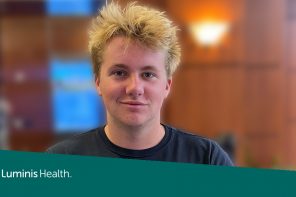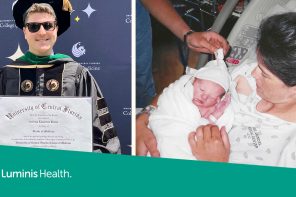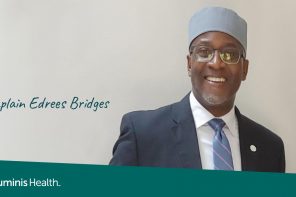It was a typical evening as Amanda Brady chatted with her 16-year-old and eldest of three children, Lee. As the two sat in Lee’s room talking and sharing laughs, Amanda spotted a Post-It note stuck to the wall. Small, handwritten scribbles outlined some of the goals Lee wanted to accomplish that year. One goal in particular stood out to Amanda. It read, “Come out as pansexual by the end of the school year.”
“I was totally confused because I had no idea what pansexual meant,” Amanda recalls. According to the Human Rights Campaign (HRC), pansexual describes someone who has the potential for emotional, romantic or sexual attraction of people of any gender though not necessarily simultaneously, in the same way or to the same degree. Soon after this, Lee asked his family to refer to him by the gender-neutral pronoun “they” while also noticeably becoming more isolated and depressed.
The turning point
It was during senior year of high school when Lee started self-harming and was eventually hospitalized because of suicidal ideation. “The hospitalization was rock bottom for our family, but it was also a blessing in disguise,” says Amanda.
In talking with a counselor at the hospital, Lee opened up about identifying as transgender. While there, Lee, who was born female, also firmly stated that he wanted to be referred to as “he” or “they” and changed his name from Liana to Lee. “My husband and I were willing to support him in whatever he wanted to do,” says Amanda. “We told him that we loved him whether they were ‘her’ or ‘him.’”
Amanda, who works as a clinical director of nursing at Anne Arundel Medical Center (AAMC), was determined to support her son and help him get through this dark time. Amanda says her family sought therapy, got Lee treatment for depression and anxiety and found an endocrinologist to start him on testosterone. “It hurt my feelings when I found out,” Amanda says admittedly, “but I never said I didn’t want him to be a boy. I always said I wanted him to be happy and that I would help the best way I could.”
Amanda also joined AAMC’s Lesbian Gay Bisexual Transgender, Queer, Intersex or Asexual (LGBTQIA) Business Resource Group, a group of employees who joined together based on shared characteristics or life experiences. She wanted to glean from others ways she could better support her son.
“The easiest part for me was when he cut his hair and started wearing male clothes because growing up I was a tomboy,” Amanda laughs as she reflects. “The hardest part was not knowing how to help him through the emotional state. He didn’t want to open up at all because he thought we wouldn’t understand.”
Acceptance, communication and support
Danny Watkins grew up in a small community in Allegany County and was raised in a traditional Catholic family. He told his parents he was gay when he was 15. To his dismay, he was faced with unacceptance and was unwillingly ‘outed’ to the rest of his family members. Traumatized, Danny tried not to be gay for the next two years to cope with pressure at home. At age 17, his family found out he was dating a boy and the family discord from years before resumed.
“I felt very isolated and lonely,” he recalls. “It’s as if I were a giant air balloon that couldn’t fit in any situation. I was just barely functioning and trying to get through the day. I didn’t have the support I needed at home so I relied heavily on my friends. They became my support system I needed to survive until the relationship with my family started to slowly get better over the next couple years.”
Danny pursued a career in nursing, moved out at 19 and worked at an inpatient psychiatric unit. He is now the director of clinical operations at Pathways, AAMC’s substance abuse and mental health treatment facility. “Working in mental health has really opened my eyes to suicidality in the LGBTQ community.”
Four in 10 LGBT youth say the community in which they live is not accepting of LGBT people, according to the HRC which surveyed more than 10,000 LGBT-identified youth ages 13-17. An estimated 26 percent of LGBT youth say problems they face include not feeling accepted by their family, having trouble at school or with bullying, and coming out or being open.
Danny advises parents with an LGBTQ child to work on acceptance first. “You should always support your child and try to approach them from a non-judgmental place,” he says. He also recommends keeping the lines of communication open and meeting your child’s friends as important steps to take. “Reassure your child that you love them and that you support them, no matter who they are inside.”
Danny also advises parents to find a good support system by joining local support groups and finding a counselor in the school or community who can provide support and resources.
Silver lining
Amanda and her husband have fully accepted their son’s decision to come out as transgender. Amanda is also observing Lee becoming more comfortable with himself. Lee is currently a freshman in college. She says he is growing facial hair for the first time. “He has really blossomed,” she adds.
Even as someone who has an LGBT child, Amanda admits she still doesn’t know all there is to know about the community but is committed to furthering her understanding so she can continue to support her son.
“If you isolate your child because you don’t see eye to eye, that’s a very boring and lonely existence to live,” she says. “Love your child for who they are, that’s the bottom line.”
Anne Arundel Medical Group (AAMG) Mental Health Specialists offers care for diverse mental health needs for adults and children ages six years and older. For more information, visit myAAMG.org/mental-health-specialists.




